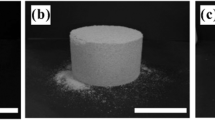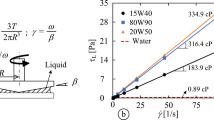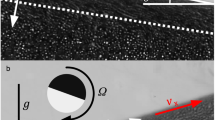Abstract
Anyone who has built a sandcastle recognizes that adding liquid to the sand grains increases the overall stability. However, measurements of the stability in wet granular materials often conflict with theory and with each other1,2,3,4,5,6,7. The friction-based Mohr–Coulomb model3,8 distinguishes between granular friction and interparticle friction, but uses the former without providing a physical mechanism. A frictionless model for the geometric stability of dry particles on the surface of a pile2 is in excellent agreement with experiment. However, the same model applied to wet grains overestimates the stability and predicts no dependence on system size. Here we take a frictionless liquid-bridge model and perform a stability analysis within the pile. We reproduce our experimentally observed dependence of the stability angle on system size, particle size and surface tension. Furthermore, we account for past discrepancies in experimental reports by showing that sidewalls can significantly increase the stability of granular material.
This is a preview of subscription content, access via your institution
Access options
Subscribe to this journal
Receive 12 print issues and online access
$259.00 per year
only $21.58 per issue
Buy this article
- Purchase on SpringerLink
- Instant access to full article PDF
Prices may be subject to local taxes which are calculated during checkout




Similar content being viewed by others
References
Hornbaker, D., Albert, R., Albert, I., Barabási, A. L. & Schiffer, P. What keeps sandcastles standing? Nature 387, 765 (1997).
Albert, R., Albert, I., Hornbaker, D., Schiffer, P. & Barabási, A. L. Maximum angle of stability in wet and dry spherical media. Phys. Rev. E 56, 6271–6274 (1997).
Halsey, T. C. & Levine, A. J. How sandcastles fall. Phys. Rev. Lett. 80, 3141–3144 (1998).
Fraysse, N., Thome, H. & Petit, L. Humidity effects on the stability of a sandpile. Eur. Phys. J. B 11, 615–619 (1999).
Nase, S. T., Vargas, W. L., Abatan, A. A. & McCarthy, J. J. Discrete characterization tools for cohesive granular materials. Powder Technol. 116, 214–223 (2001).
Samadani, A. & Kudrolli, A. Angle of repose and segregation in cohesive granular matter. Phys. Rev. E 64, 050301 (2001).
Tegzes, P., Vicsek, T. & Schiffer, P. Avalanche dynamics in wet granular materials. Phys. Rev. Lett. 89, 094301 (2002).
Nedderman, R. M. Statics and Kinematics of Granular Materials (Cambridge Univ. Press, Cambridge, England, 1992).
du Pont, S. C., Gondret, P., Perrin, B. & Rabaud, M. Wall effects on granular heap stability. Europhys. Lett. 61, 492–498 (2003).
Lian, G., Thornton, C. & Adams, M. J. A theoretical study of the liquid bridge forces between two rigid spherical bodies. J. Colloid Interface Sci. 161, 138–147 (1993).
Groger, T., Tuzun, U. & Heyes, D. M. Modeling and measuring of cohesion in wet granular materials. Powder Technol. 133, 203–215 (2003).
Acknowledgements
We thank J. Norton and N. Israeloff for their help with the apparatus, and J. Bico for feedback on the manuscript. The work was supported by the National Science Foundation Grant No. DMR-9983659, and the GLUE program of the Department of Energy.
Author information
Authors and Affiliations
Corresponding author
Ethics declarations
Competing interests
The authors declare no competing financial interests.
Rights and permissions
About this article
Cite this article
Nowak, S., Samadani, A. & Kudrolli, A. Maximum angle of stability of a wet granular pile. Nature Phys 1, 50–52 (2005). https://doi.org/10.1038/nphys106
Received:
Revised:
Accepted:
Published:
Issue date:
DOI: https://doi.org/10.1038/nphys106
This article is cited by
-
Experiments on seepage-triggered cliff landslides using cohesive wet sand
Progress in Earth and Planetary Science (2022)
-
Universal aspects of cohesion
Granular Matter (2022)
-
The slope of dry granular materials surface is generally curved
Granular Matter (2022)
-
Magnetic Janssen effect
Nature Communications (2021)
-
On the Mechanism of Laboratory Earthquake Nucleation Highlighted by Acoustic Emission
Scientific Reports (2020)



